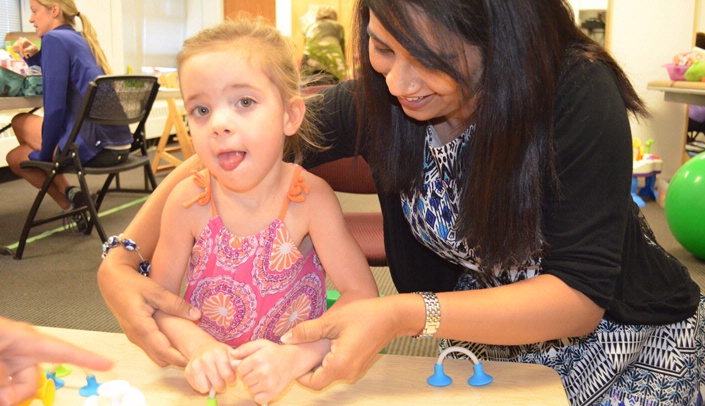As Swati Surkar encourages her, 3-year-old Lily uses both her hands to pull a suction cup free from the table in front of her. As the cup comes loose with a soft “pop,” Surkar and Lily’s mother, Sunny Reynolds, cheer.
About the camp
The Hand, Arm, Bimanual Intensive Training intervention project is supported by the education grant received by Surkar from the World Bank’s Margaret McNamara Memorial Fund. Surkar, a doctoral student in UNMC’s Medical Sciences Interdisciplinary Area (MSIA) graduate program, is running the camp under the direction of Sandra Willett, interim director of physical therapy, and Janice Flegle, director of occupational therapy.
Lily is one of six children, ages 3 to 6, with hemiplegic cerebral palsy who is attending the Hand, Arm, Bimanual Intensive Training (HABIT) day camp. The camp is being run at the Munroe-Meyer Institute by Surkar, a doctoral student in the rehabilitation sciences graduate program, as part of her dissertation research.
The idea behind the two-week camp is simple: Hide intensive bimanual therapy inside fun activities, with two volunteers working intensively with each child.
“Children with hemiplegic cerebral palsy usually have weakness on one side,” Swati said. “We are trying to give the intervention in such a way that their bimanual coordination will improve.”
So there are a lot of play activities — the suctions cups, toy tools, a basketball hoop, clay. But each has a purpose.
“We have therapy goals for each child, and through play, we are trying to work on those goals.”
Reynolds says both she and her daughter have been enjoying the camp.
“She has lots of toys to play with, and other kids to watch and play with also, so she’s having fun,” Reynolds said. “I think the experience has been very positive for her, and I hope the therapy will help her.”
Kristen Topliff, a physical therapy student at UNMC, said play is important.
“With an adult, you can tell them to do something and they’ll do it, because they know it’s important, but with kids that doesn’t work. You have to make it a game. A kid’s job is to play.”
Aarika Olsen, a volunteer and early childhood educator, said it was inspiring to see the children developing their skills.
“The girl I work with, I don’t think she would do as well with normal therapeutic interventions. Without it being a game she wouldn’t be interested, so this really gets her engaged in using both arms.”
Surkar was pleased with the success of the camp, which ended Aug. 7.
“As far as the kids’ progress working with volunteers, I’m really satisfied,” she said. She’d like to continue the camp in the future, perhaps with therapies that involve not just the upper limbs but involve the lower limbs as well.
“Definitely we are thinking about it,” she said.

A novel way. It will work. Children love ply. So they will repeat it and it will work. Great efforts
Good work mam…w all r proud of u
good work mam